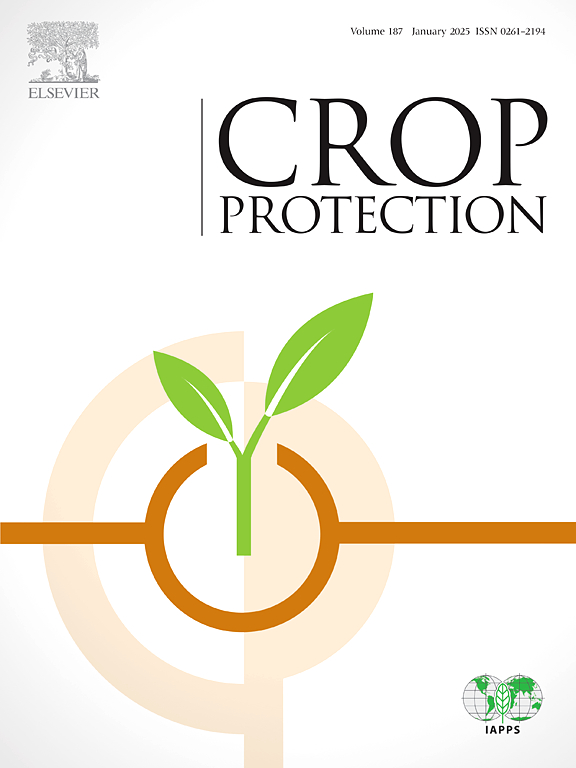A rapid estimation of intra-row weed density using an integrated CRM, BTSORT and HSV model across entire video stream of chilli crop canopies
IF 2.5
2区 农林科学
Q1 AGRONOMY
引用次数: 0
Abstract
Intra-row weeds have a significant impact on crop yield and health, competing with crops for nutrients, water, and sunlight. Traditional uniform herbicide applications in weed management not only risk harming the environment but can also compromise crop health. Precision spraying technology, guided by machine vision, offers a solution by accurately identifying and targeting weeds, thereby reducing overall herbicide use. Inter-row weed segmentation can be done easily with simple thresholding, but intra-row region weed cannot be segmented with simple thresholding due to many similarities between the intra-row weeds and plants. So, in this study, a novel methodology is introduced to dynamically estimate intra-row weed density for the entire crop row of chilli by integrating ByteTrack Simple Online and Real Time Tracker (BTSORT) with YOLOv7 crop recognition model to track the plant and Hue-Saturation-Value (HSV) color model with simple thresholding to segment weeds between tracks to avoid repetitive intra-row weed density estimation. The weed density between the plants in these regions is calculated and categorized into low, medium, and high levels based on the number of weed pixels in the intra-row region. The YOLOv7 Crop recognition model recognized the chilli plants with achieved a precision of 0.92 and a recall of 0.94 at 47.39 FPS. The BTSORT with YOLOv7 crop recognition model on a test video dataset performed well with MOTA and MOTP of 0.85 and 0.81, respectively. The developed dynamic intra-row weed density estimation method classifies it with an overall accuracy of 0.87. Additionally, the system processed 1280x720 frames 1.38 times faster than 1920x1080 frames, enabling efficient real-time intra-row weed density estimation across full crop rows.
利用综合 CRM、BTSORT 和 HSV 模型,在辣椒作物树冠的整个视频流中快速估算行内杂草密度
行内杂草与作物争夺养分、水分和阳光,对作物的产量和健康有很大影响。在杂草管理中,传统的均匀施用除草剂的方法不仅有危害环境的风险,还会损害作物健康。由机器视觉引导的精准喷洒技术提供了一种解决方案,它能准确识别杂草并锁定目标,从而减少除草剂的总体用量。行间杂草的分割可以通过简单的阈值处理轻松完成,但由于行内杂草与植物之间存在许多相似之处,因此无法通过简单的阈值处理分割行内杂草。因此,本研究引入了一种新方法,通过将 ByteTrack Simple Online and Real Time Tracker(BTSORT)与 YOLOv7 作物识别模型相结合来跟踪植物,并使用色相-饱和度-值(HSV)颜色模型和简单阈值来分割轨迹间的杂草,从而动态估计辣椒整个作物行的行内杂草密度,以避免重复估计行内杂草密度。根据行内区域杂草像素的数量,计算出这些区域内植物之间的杂草密度,并将其分为低、中、高三个等级。YOLOv7 作物识别模型在 47.39 FPS 下识别辣椒植物的精确度为 0.92,召回率为 0.94。使用 YOLOv7 农作物识别模型的 BTSORT 在测试视频数据集上表现良好,MOTA 和 MOTP 分别为 0.85 和 0.81。所开发的动态行内杂草密度估算方法对其进行分类的总体准确率为 0.87。此外,该系统处理 1280x720 帧的速度是 1920x1080 帧的 1.38 倍,实现了高效的实时作物行内杂草密度估算。
本文章由计算机程序翻译,如有差异,请以英文原文为准。
求助全文
约1分钟内获得全文
求助全文
来源期刊

Crop Protection
农林科学-农艺学
CiteScore
6.10
自引率
3.60%
发文量
200
审稿时长
29 days
期刊介绍:
The Editors of Crop Protection especially welcome papers describing an interdisciplinary approach showing how different control strategies can be integrated into practical pest management programs, covering high and low input agricultural systems worldwide. Crop Protection particularly emphasizes the practical aspects of control in the field and for protected crops, and includes work which may lead in the near future to more effective control. The journal does not duplicate the many existing excellent biological science journals, which deal mainly with the more fundamental aspects of plant pathology, applied zoology and weed science. Crop Protection covers all practical aspects of pest, disease and weed control, including the following topics:
-Abiotic damage-
Agronomic control methods-
Assessment of pest and disease damage-
Molecular methods for the detection and assessment of pests and diseases-
Biological control-
Biorational pesticides-
Control of animal pests of world crops-
Control of diseases of crop plants caused by microorganisms-
Control of weeds and integrated management-
Economic considerations-
Effects of plant growth regulators-
Environmental benefits of reduced pesticide use-
Environmental effects of pesticides-
Epidemiology of pests and diseases in relation to control-
GM Crops, and genetic engineering applications-
Importance and control of postharvest crop losses-
Integrated control-
Interrelationships and compatibility among different control strategies-
Invasive species as they relate to implications for crop protection-
Pesticide application methods-
Pest management-
Phytobiomes for pest and disease control-
Resistance management-
Sampling and monitoring schemes for diseases, nematodes, pests and weeds.
 求助内容:
求助内容: 应助结果提醒方式:
应助结果提醒方式:


